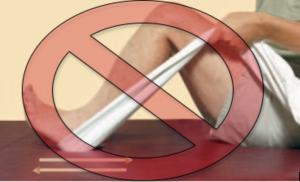by Mitch Hauschildt, MA, ATC, CSCS
One of the first things clinicians learn about post op patients is to improve their range of motion as  quickly as possible. Because, in order to have joint stability, you have to have joint mobility. Over the years of working with tons of knee patients, I have found a really simple and effective method for improving knee flexion. For one reason or another, I have never been a huge fan of towel or wall slides to improve knee flexion, so I have always tried hard to find other methods. I’m a little more likely to use a bike to assist their range of motion, but I’m not a fan of using it for the primary means of gaining range of motion, nor am I a fan of using it in the first few days post op.
quickly as possible. Because, in order to have joint stability, you have to have joint mobility. Over the years of working with tons of knee patients, I have found a really simple and effective method for improving knee flexion. For one reason or another, I have never been a huge fan of towel or wall slides to improve knee flexion, so I have always tried hard to find other methods. I’m a little more likely to use a bike to assist their range of motion, but I’m not a fan of using it for the primary means of gaining range of motion, nor am I a fan of using it in the first few days post op.
A technique that I have found that works really well is combining Positional Release Therapy (PRT) for the psoas with passive knee flexion. I stumbled across the technique while performing PRT on a psoas the day after surgery (which is greatly needed because their psoas is always dysfunctional after knee surgery). While holding the leg in a comfortable and relaxed position, it just made sense to start flexing the knee while their leg was limp in my hand. The patient liked it and I saw really nice improvements, so I ran with it. It is now our standard method for improving knee flexion at our facility.
I like it for several reasons:
- It allows the patient to fully relax and I only initiate the passive knee flexion when I feel their leg go limp in my arm.
- It maximizes my treatment time because I can perform soft tissue work on the psoas and work on knee flexion at the same time.
- It develops a lot of trust with my patient early on in the rehab process.
The easiest way to explain this method is to see it in action, so I shot a quick video to demonstrate it in action. Check it out!


Leave a Reply